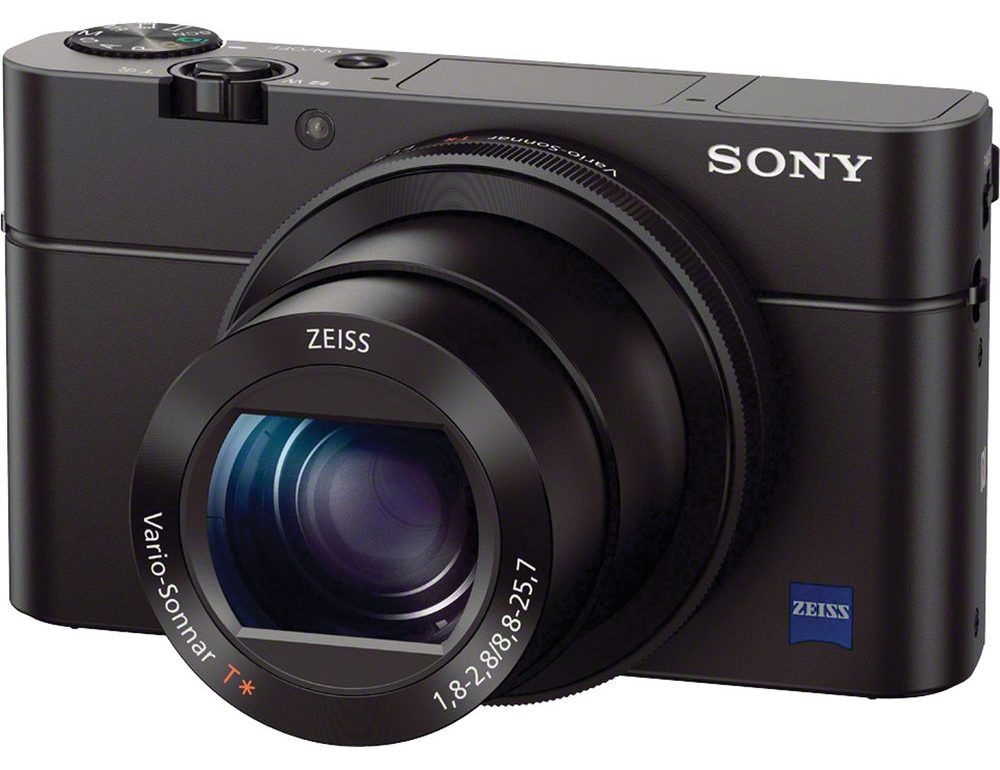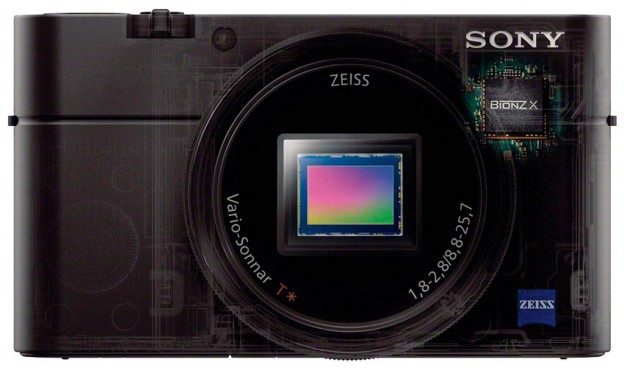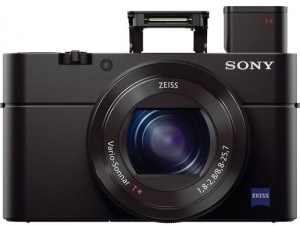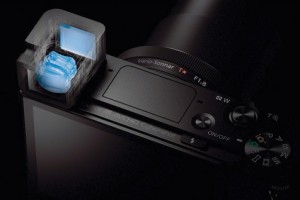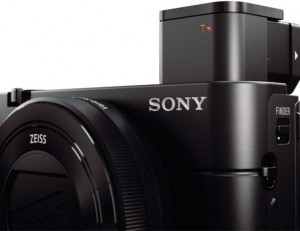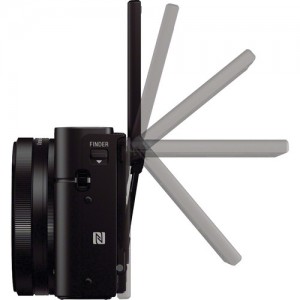Sony just announced the Cyber-shot RX100 III digital camera, and it really looks like the best pocket sized point and shoot camera ever made! I have personally loved the RX100 series over the years and Sony listened to every nitpick we had and addressed them perfectly from the looks of it! The original RX100 had no articulating screen but they addressed that in the second generation along with a hot shoe and slightly better sensor for lower light shooting. It was a decent effort, but I was honestly not that impressed with the improvements from the first generation. This time it looks like Sony nailed it and managed to keep the price extremely fair at only $798 US.
The only major feature missing on the RX100 II was the lack of a viewfinder for bright daylight shooting, and Sony found a way to fit a pop-up style unit! Amazing… Actually the touch screen was also missing and they did not include that this time. The lcd screen is a very high quality unit though with white magic technology and 1440k resolution.
Sony dropped the hot shoe which does limit the camera use for that type of shooting unfortunately. The RX100 series is really not designed for that type of photography though, and I really think it was a smart move to drop it honestly. I can see a few folks getting upset that really enjoyed that powerful feature though. It’s designed to fit in your pocket, so trying to make it an all-in-one pro camera is not practical. Creating the sister RX10 camera makes a lot more sense, and if you want to do studio work, get that camera instead!
Sony is marketing this camera to pro’s who want the best point and shoot available, so most likely they will have a studio camera or something else for the actual professional work. That makes total sense me from my personal perspective.
Bravo for really ironing out a few wrinkles and delivering us Sony fans the best RX-series cameras to date!
Sony RX100 III Pre-orders now available for ~$799 US @ BHPhoto | Amazon | Sony
Sony’s official claim:
The best pocket camera
we’ve ever made.
RX100 III Camera Porn
Oh yeah…. Click Photos for higher res versions
Sony RX100 III Overview
Courtesy to BHphoto:
The Sony Cyber-shot DSC-RX100 III Digital Camera is a versatile and advanced point-and-shoot featuring a large 20.1 megapixel 1″ Exmor R CMOS sensor to produce high-resolution still imagery and full HD video. This sensor’s design utilizes backside-illuminated technology to improve clarity and image quality when working in dimly-lit conditions as well as increase the sensitivity to a native ISO 12800. Benefiting the performance of this sensor is the BIONZ X image processor, which helps to produce images with smooth quality and tonal gradations as well as provide expedited performance throughout all aspects of the camera, including a continuous shooting rate of 10 fps in Speed Priority mode, shutter release lag of 0.008 sec., and XAVC S movie recording at 50 Mbps.
The built-in Carl Zeiss Vario-Sonnar T* 2.9x zoom lens provides a 35mm-equivalent focal length range of 24-70mm, covering wide-angle to portrait-length perspectives to suit working in a wide variety of environments. An f/1.8-2.8 maximum aperture benefits working in low lighting and controlling focus throughout the zoom range. Optical SteadyShot image stabilization is also available to help minimize the appearance of camera shake when working in dimly-lit conditions and with greater zoom magnifications. Furthermore, a built-in three-stop ND filter is incorporated into the camera’s design to suit shooting in bright conditions with wider apertures and for greater control over how movement is depicted. The lens also features a Carl Zeiss T* anti-reflective coating, which helps to reduce surface reflections, lens flare, and ghosting in order to produce imagery that is rich in contrast and clarity.
Complementing the imaging capabilities of the RX100 III is a sleek body design featuring both an electronic viewfinder and a tilting LCD screen. The 0.39″ 1,440k-dot SVGA OLED Tru-Finder has Zeiss T*-coated optics and provides a bright, clear means for eye-level viewing. It features a unique pop-up mechanism that helps to maintain the compact form factor of the camera when carrying or if preferring to work with the rear screen. The 3.0″ 1,229k-dot Xtra Fine LCD incorporates WhiteMagic technology for easier visibility in bright conditions and its tilting design permits greater usability from high, low, and front-facing angles. Furthermore, built-in Wi-Fi connectivity with NFC allows instant image sharing to, as well as remote camera control and monitoring from, linked mobile devices.
RX100 III – Features and Specifications
- 20.1MP 1″ Exmor R BSI CMOS Sensor and BIONZ X Image Processor
- The large 20.1 megapixel 1″ Exmor R CMOS sensor features backside-illuminated technology to enhance its low-light capabilities to a native ISO 12800 while still retaining vivid clarity. Using Sony’s Column A/D Conversion and area-specified noise reduction, images are rendered with impressive quality and smooth gradations between tones and colors due to the marked, intelligent reduction in apparent noise. Further enhancing imaging quality, detail reproduction technology works to increase the fine detail rendering capabilities for a more three-dimensional, realistic image quality while diffraction-reducing technology helps to enhance the optical qualities of the lens by suppressing diffraction that is common when working at smaller apertures. Additionally, aiding working in difficult lighting conditions, the sensitivity can be extended to an effective ISO 25600 when using Multi-Frame NR, which records and composites sequential images in order to attain high sensitivity with minimal noise.Also benefitting the image quality, as well as overall camera performance, is the BIONZ X image processor, which provides continuous shooting up to 10 fps in Speed Priority Mode, 2.9 fps shooting with single-shot AF, a shutter lag time of just 0.008 sec., and a start-up time of 1.6 sec.
- Zeiss Vario-Sonnar T* Lens
- The built-in Zeiss Vario-Sonnar T* lens provides a 35mm-equivalent focal length range of 24-70mm, covering wide-angle to portrait length perspectives to suit working in a wide variety of shooting conditions. An f/1.8-2.8 maximum aperture benefits working in difficult lighting conditions throughout the entire zoom range and also enables greater control over focus placement for shallow depth of field imagery, which is further accentuated by a seven-blade diaphragm to produce a smooth out-of-focus quality. Nine aspherical elements, including two cemented AA (advanced aspherical) elements, are incorporated into the lens design to minimize chromatic aberrations throughout the zoom range to benefit creating sharp, clear imagery. The lens also features a Carl Zeiss T* anti-reflective multi-layered coating to help minimize lens flare and ghosting in order to produce imagery with rich contrast and color neutrality.Benefitting the 2.9x reach of this lens, as well as supporting working in difficult lighting conditions and with longer shutter speeds, is Optical SteadyShot image stabilization, which helps to offset the effects of camera shake. When recording movies, the image stabilization utilizes an Intelligent Active Mode, which also uses electronic image stabilization to compensate for both camera shake and rolling shutter effects.Additionally, a neutral density 0.9 filter is incorporated into the camera’s design, which provides a reduction of three stops in exposure to enable working in bright conditions with wider aperture settings and for greater control over how subject movement is rendered.
- Camera Design
- Within the compact design of the RX100 III is both a high-resolution electronic viewfinder and a large rear LCD monitor. The 0.39″ 1,440k-dot SVGA OLED Tru-Finder EVF provides a bright, clear means for eye-level monitoring, which is well-suited to critical compositions and working in bright conditions. It features 100% frame coverage, a unique pop-up mechanism, and a Zeiss T* coating on the optics to reduce surface reflections and flare for enhanced visibility. Alternatively, a 3.0″ 1,229k-dot Xtra Fine LCD screen is also available and features a tilting design (180° up, 45° down) to benefit working from high, low, and front-facing angles. WhiteMagic technology has been applied to the LCD’s design, too, to increase effective brightness for easier viewing in bright lighting. When working with both viewing means, an integrated eye sensor automatically switches between both the EVF and LCD. Additionally, the camera can be turned on simply by popping the EVF into place.For intuitive, SLR-like adjustments over a variety of camera settings, a manual control ring surrounds the lens and features a smooth, click-less design for quick and quiet changing of settings. The ring can be assigned to control a variety of features, at different values, such as zoom, aperture, and Picture Effects. A step-zoom feature can be utilized, too, to allow instant switching between commonly used focal lengths.
- Full HD Video Recording
- Full HD 1920 x 1080 movies can be recorded in the high-quality XAVC S format, which uses a Long GOP (Group of Pictures) structure, MPEG-4 AVC/H.264 video compression, and linear PCM audio compression, and saves within the MP4 container format. These compressed files permit recording times up to 29 minutes while allowing 50 Mbps video recording at 1080/60p, 1080/30p, 1080/24p, and 720/120p frame rates. Full-pixel readout helps to minimize any artifacts in recordings due to the ability to utilize data from the entire image sensor, which ultimately results in smooth, high-resolution recordings. Movies can also be recorded in the AVCHD format, which is ideal for HDTV playback and Blu-ray disc burning, and the MP4 format, which is ideal for uploading online. Additionally, when shooting for two purposes in mind, dual recording is possible in different formats-XAVC S and MP4 or AVCHD and MP4-for the ability to instantly share footage while also having a higher quality version for subsequent editing.Benefitting advanced video applications, the RX100 III also supports clean HDMI output for recording uncompressed video via an optional external recorder and for real-time viewing on an accessory monitor. Recording frame rates include 24p, 60p, and 60i, and the shooting info display can be turned off during recording for a cleaner view when utilizing an external monitor.
- Built-In Wi-Fi Connectivity with NFC
- Built-in Wi-Fi connectivity enables instant transferring of imagery to mobile devices for direct sharing online to social networking, via email, and to cloud storage sites. NFC (Near Field Communication) is also supported, which allows for one-touch connection between the camera and compatible mobile devices, with no complex set-up required. Once connected, the linked mobile device can also display a live view image on its screen and, using Smart Remote Control, remotely control the camera’s shutter release.Additionally, PlayMemories Camera Apps are also supported via the built-in Wi-Fi connection, and allow you to personalize the camera’s features depending on specific shooting styles. Apps are available to suit creating portraits, detailed close-ups, sports, time lapse, motion shot, and other specific types of imagery.
- Other Camera Features
-
- A contrast-detection autofocus system works to acquire precise focus using single-shot or continuous AF modes. When working with moving subjects, Lock-on AF, with wide, center, and flexible spots, adjusts the target frame size as the subject moves throughout the image frame. Face detection and face registration technologies can be used to base focus on recognized faces and Eye AF is also available, which is a detail-oriented focusing function that prioritizes and dedicates focusing performance on a subject’s pupil for sharply-rendered portraits.
- For manual focus control, DMF (Direct Manual Focus) and standard manual focus options are available. Benefitting precise manual focus, focus peaking can be used, which highlights edges of contrast within the frame for a more objective means of determining critical sharpness, or MF Assist is available, which enlarges the image for a better view of important details.
- A zebra function can be used for easier detection of exposure clipping to prevent overexposure.
- A dedicated Custom button permits assigning of one of 42 possible functions for instant, one-touch access to a chosen control.
- A digital level gauge detects pitch and roll types of movement and helps to produce even, consistent horizons and plumb verticals.
- Smile Shutter technology enables the camera to automatically release the shutter when a subject’s smile is detected
- Multi Frame NR records consecutive images at a reduced ISO sensitivity and then composites them into a single image to realize higher effective sensitivity (up to an equivalent ISO 25600) with minimal image noise. Standard image compositing is comprised of four exposures and High image compositing utilizes 12 distinct exposures.
- Dynamic Range Optimizer (DRO) works to improve images featuring backlit subjects or scenes with high contrast where details can be lost in the shadows or highlights. This mode can be controlled automatically or fine-tuned using five settings.
- Picture Effect modes allow you to apply creative settings and emphasize certain facets of individual images for a richer, more aesthetic picture quality. Posterization (Color/B&W), Pop Color, Retro Photo, Partial Color (R/G/B/Y), High Contrast Monochrome, Toy Camera, Soft High-Key, Soft Focus, HDR Painting, Rich-Tone Monochrome, Miniature, Watercolor, and Illustration modes are available.
- Creative Style settings provide control over how the camera processes images based on different predetermined styles: Standard, Vivid, Neutral, Clear, Deep, Light, Portrait, Landscape, Sunset, Night Scene, Autumn Leaves, Black & White, Sepia, and Style Box. Within these settings, contrast, saturation, and sharpness can also be adjusted depending on personal preference.
- To extend the effective reach of the optical zoom lens, Clear Image digital zoom can be used to intelligently magnify scenes up to 5.8x at full-resolution. This digital zoom technology uses an intelligent interpolation process to minimize the amount of image degradation in order to produce realistic, high-quality images.
- In-camera creation of 4K slide shows is possible for rich playback to ultra high definition televisions. An HDMI port is incorporated into the camera’s design, too, to enable direct connection to HDTVs.
- TRILUMINOS Color support is supported to produce rich, natural colors when imagery is viewed on a TRILUMINOS Display.
-
-
Software
-
- Operating System Compatibility : PlayMemories Home: Windows® XP SP3, Windows Vista® SP2, Windows®7 SP1, Windows®8 (PlayMemories Home is not Mac compatible); PlayMemories Online Uploader: Windows XP SP3, Windows Vista®SP2, Windows®7 SP1, Windows®8, Mac OS X (v10.5- v10.8); Image Data Converter Version 4.2: Windows® XP SP3,Windows Vista® SP2,Windows®7 SP1,Windows®8, Mac OS X (v10.5- v10.8)
- Supplied Software : Supplied Software: PlayMemories™ Home, Image Data Converter Version 4 (via software download from camera)
-
-
-
-
Advanced Features
-
- Image Stabilization : [Still Image] Optical [Movie] Active Mode, Optical type with electronic compensation (Anti-rolling)
-
- Auto High Dynamic Range : Yes, (Auto Exposure Difference, Exposure difference Level (1-6 EV at 1.0 EV step), off)
-
- Sweep Panorama : Horizontal (Wide/Standard), Vertical (Wide/Standard)
-
- Face Detection : On, Off, Face Registration, Face Selection; maximum eight faces detected
-
- Priority Setting (for Face Detection) : Yes (eight faces max) New Registration / Order Exchanging / Delete / Delete All
- Smile Shutter™ technology : Smile shutter (selectable from 3 steps)
-
-
-
-
Camera
-
- Camera Type : Cyber-shot® Digital Still Camera
- Lens Compatibility : Fixed lens
-
-
-
-
- Color : Black
-
-
-
Convenience Features
-
- Media/Battery Indicator : Yes
- View & Index : Single (with or without shooting information), RGB histogram and highlight/shadow warning, 4/9-frame index view, Enlarged display mode (L: 13.6x, M: 9.9x, S: 6.8x), Auto Review (10/5/2 sec, Off), Image orientation (On/Off), Slideshow, Panorama scrolling, Folder selection (still), Forward/Rewind (movie), Delete, Protect
-
-
-
-
Drive System
-
- Continuous Shooting Speed : 10 fps at 20.2MP
-
- Burst Buffer : JPEG Standard (12 shots) JPEG Fine (12 shots) RAW (13 shots) RAW+JPEG (10 shots)
-
- Shutter Speeds : iAuto (4 – 1/2000) / Program Auto (1 – 1/2000) / Manual (Bulb, 30 – 1/2000) / Aperture Priority (8 – 1/2000) / Shutter Priority (30 – 1/2000)
-
- Self-timer : 10 sec. / 2 sec. / Self-portrait One-person/ Self-portrait Two-person/ Self timer Continuous (3 or 5 shots)
- Drive Mode : Single-shot, Continuous, Speed Priority Continuous, Self-timer (10/2 sec. delay), Self-timer (Cont.), Self-portrait One-person, Self-portrait Two-person, (with 10 sec. delay; 3/5 exposures), Bracketing
-
-
-
-
Exposure System
-
- D-Range Optimizer : Off, Dynamic Range Optimizer (Auto/Level 1-5), Auto High Dynamic Range: Off, Auto Exposure Difference, Exposure difference Level (1.0-6.0EV, 1.0EV step)
-
- Auto Exposure Lock : Yes (AE Lock button). Can be disabled from menu
-
- Exposure Compensation : +/- 3.0 EV, 1/3 EV step
-
- Minimum Illumination : Movie: Auto:1.2lux(Shutter Speed 1/30″)
-
- Picture Effect(s) : [Still Image] Toy Camera, Pop Color, Posterization, Retro Photo, Soft High- key, Partial Color, High Contrast Monochrome, Soft Focus, HDR Painting, Rich-tone Monochrome, Miniature, Watercolor, Illustration [Movie] Toy Camera, Pop Color, Posterization, Retro Photo, Soft High-key, Partial Color, High Contrast Monochrome
-
- Exposure Settings : [Still] Superior Auto, Intelligent Auto, Program Auto (Program shift available), Shutter Priority, Aperture Priority, Manual, Scene Selection, Movie, Sweep Panorama [Movie] Program Auto, Aperture Priority, Shutter Priority, Manual
-
- Scene Mode(s) : Anti Motion Blur, Fireworks, Gourmet, Handheld Twilight, High Sensitivity, Landscape, Macro, Night Portrait, Night Scene, Pet Mode, Portrait, Sports Action, Sunset
-
- Metering Modes : Multi-segment, Center-weighted, Spot
-
- Metering Sensitivity : EV 0 to 20 (at ISO100 equivalent)
-
- ISO : Auto(ISO125-12800, selectable with upper / lower limit),125/160/200/250/320/400/500/640/800/1000/1250/1600/2000/2500/3200/4000/5000/6400/8000/10000/12800 (Extendableto ISO80/100),Multi-Frame NR:Auto(ISO125-12800), 200/400/800/1600/3200/6400/12800/25600
-
- Creative Style : Standard, Vivid, Neutral, Clear, Deep, Light, Portrait, Landscape, Sunset, Night Scene, Autumn Leaves, Black & White, Sepia, Style Box
-
- Color Temperature : 2500 – 9900K with 15-step each Magenta/Green compensation (G7 to M7), Amber/Blue (A7 to B7), Custom
-
- ISO Sensitivity (Movie) : Auto:(ISO125Level-ISO12800Level, selectable with upper / lower limit), 125/160/200/250/320/400/500/640/800/1000/1250/1600/2000/2500/3200/4000/5000/6400/8000/10000/12800
-
- White Balance Mode : Auto / Daylight / Shade / Cloudy / Incandescent / Fluor (Warm White) / Fluor (Cool White) / Fluor (Day White) / Fluor (Daylight) / Flash / C. Temp., Filter / Custom
-
- Exposure Bracketing : 3 continuous or single shots in 1/3 or 2/3 EV steps
- WB Shift : G7-M7,A7-B7
-
-
-
-
Flash
-
- Flash Bracketing : ±2.0 EV
-
- Flash Metering System : Pre-flash TTL
-
- Flash Compensation : ±2.0 EV (switchable between 1/3 EV steps)
-
- Recycling Time : Approx. 3.4 sec.
-
- Flash Modes : Auto / Fill-flash / Slow Sync / Rear Sync / Off
-
- Flash Coverage : ISO Auto: 1’ to 49’ 2” (0.30m to 15.0m) (W) / 1’ 9” – 18’ 8” (0.55m to 5.7m) (T) ISO 12800: Up to 98’ 5” (30.0m) (W) / 37’ (11.3m) (T)
- Flash Type : Built-in, Pop-up Auto
-
-
-
-
Focus Control
-
- Focus Features : Predictive control (AF-A, AF-C), Focus Lock
-
- AF Illuminator : Built-in LED, Range: approx. 3′ 4” – 9′ 9” (0.3m-3.0m)
-
- Focus Sensitivity : EV 0 to 20 EV (at ISO100 equivalent)
-
- Focus Area : Multi point AF (25 points) / Continuous AF / Single Shot AF / Flexible spot (S/M/L) / Lock on AF (Wide/Center/Flexible Spot (S/M/L))
-
- Focus Points : 25 points
-
- AF Modes : Single-shot AF (AF-S) / Continuous AF (AF-C) / Direct Manual Focus (DMF) / Manual Focus
- Focus System : Contrast-detect AF
-
-
-
-
Imaging Sensor
-
- Pixel Gross : 20.9M pixels (approx.)
-
- Focal Length Conversion Factor : 2.7x
-
- Color Filter System : RGB primary color filters
-
- Effective Picture Resolution : 20.1M pixels (approx.)
-
- Imaging Sensor : Exmor® R 1.0” CMOS sensor (13.2 X 8.8mm) (3:2 aspect ratio)
- Processor : BIONZ® X image processor
-
-
-
-
Interface
-
- NFC : Yes (NFC Forum Type 3 Tag compatible, One-touch remote, One-touch sharing)
-
- DC IN : Yes, via AC-UB10 AC charger and USB cable
-
- Memory Card Slot : Dual compatibility slot: Memory Stick PRO Duo™/Pro-HG Duo™/PRO-HG HX Duo™ media – SD, SDHC and SDXC memory card
-
- HD Output : HDMI® (Type D micro)
-
- Wi-Fi : Yes
-
- Accessory Shoe : Multi Interface Shoe
-
- Tripod Mount : Yes (1/4″ diameter, 20 threads per inch)
-
- Remote Commander : Yes, via RM-VPR1
-
- PhotoTV HD : Yes, with BRAVIA Sync enabled HDTV and HDMI® cable
-
- USB Port(s) : USB 2.0 Hi-speed (mass-storage, MTP)
-
- BRAVIA® Sync™ : Yes, via HDMI® with compatible BRAVIA HDTV (link menu)
- Microphone Input : Via MI Shoe + Optional ECM-XYST1M
-
-
-
-
LCD Display
-
- Peaking : Yes Level setting: High/Mid/Low/Off Color: White/Red/Yellow
-
- Real-time image adjustment display : Yes (On/Off)
-
- LCD Type : 3.0” (7.5cm) (4:3) / 1,229,000 dots / Xtra Fine / TFT LCD / Tiltable (Up by approx. 180degrees, down by approx. 45degrees.)
-
- Coverage : 100% Field of View
-
- Angle Adjustment : Tilt angle: Up by approx. 180degrees, down by approx. 45degrees
-
- Histogram : Yes (On/off)
-
- Live View : Continuous Live View
-
- Brightness Control : Auto / Manual(5 steps) / Sunny Weather
-
- Grid Display : Yes (Rule of Thirds, 4×6 Square, Diagonal & 4×6 Square Grids, Off)
- Customization : Grid, Histogram display, Digital Level Gauge, Grid Line, Magnified display for playback
-
-
-
-
Optics/Lens
-
- Optical Zoom : 2.9x (Optical Zoom during movie recording)
-
- Minimum Focus Distance : iAuto: AF (W: Approx. 5cm (0.17 ft.) to Infinity, T: Approx. 30cm (0.99 ft.) to Infinity) / Program Auto: AF (W: Approx. 5cm (0.17 ft.) to Infinity, T: Approx.30cm (0.99 ft.) to Infinity)
-
- Lens Type : Carl Zeiss® Vario-Sonnar T*
-
- Aperture (Max.) : F1.8(W)-2.8(T)
-
- Aperture : F1.8 – 11 (W), F2.8 – 11 (T)
-
- Aspheric Elements : 9 aspheric elements including AA lens
-
- Aperture Blade : Iris diaphragm (7 blades)
-
- Digital Zoom : Still image: 20M Approx.11x / 10M 16x / 5M 23x / VGA 44x; Movie: Approx.11x
-
- Lens Construction : 10 elements in 9 groups (9 aspheric elements including AA lens)
-
- Steady Shot Mode:Active : [Still image] Optical [Movie] Active Mode, Optical type with electronic compensation (Anti-rolling)
-
- ND Filter : Auto / On(3 steps) / Off
-
- Clear Image Zoom : Still Image: 20M Approx. 5.8x / 10M 8.2x / 5M 11x / VGA Approx. 44x; Movie: Approx. 5.8x
- Focal Length (35mm equivalent) : [Still Image 3:2] f=24-70mm [Still Image 16:9] f=26-76mm [Still Image 4:3] f=25-73mm [Still Image 1:1] f=30.5-89mm [Movie 16:9] f=25.5-74mm (SteadyShot Standard), f=30-86mm (SteadyShot® Active Mode), f=33.5-95mm(SteadyShot Intelligent Active) [Movie 4:3] f=31-90mm (SteadyShot® Standard), f=37-105mm (SteadyShot Active Mode), f=41-117mm (SteadyShot InteligentActive)
-
-
-
-
Power
-
- Battery Type : InfoLITHIUM® NP-BX1 (3.6V)
-
- Power Requirements : AC 100V to 240V, 50/60 Hz, 70mA
-
- Power Consumption (in Operation) : Approx. 1.8W
-
- Number of Still Images : Approx. 320 images with LCD monitor (CIPA standard)
- Battery Capacity : 4.5Wh (1240mAh)
-
-
-
-
Recording
-
- Panorama Still Image Size : Wide (12,416×1,856/5,536×2,160), Standard(8,192×1,856/3,872×2,160)
-
- Audio Format : XAVC S: LPCM 2ch; AVCHD:Dolby Digital(AC-3) 2ch(Dolby Digital Stereo Creator); MP4:M PEG-4 AAC-LC 2ch
-
- Video Format : XAVC S / AVCHD Ver. 2.0 / MP4 (MPEG-4 AVC (H.264))
-
- Video Mode : XAVC S: 60p 50M(1,920×1,080/60p) / 30p 50M(1,920×1,080/30p) / 24p 50M(1,920×1,080/24p) / 120p 50M(1,280×720/120p) AVCHD: 28M PS(1,920×1,080/60p) / 24M FX(1,920×1,080/60i) / 17M FH(1,920×1,080/60i) / 24M FX(1,920×1,080/24p) / 17M FH(1,920×1,080/24p) MP4: 12M(1,440×1,080/30fps) / 3M VGA(640×480/30fps)
-
- Color Space : sRGB standard (with sYCC gamut) and Adobe RGB standard compatible with TRILUMINOS™ Color
-
- Still Image Size 16:9 : L:17M(5,472×3,080) / M: 7.5M(3,648×2,056) / S: 4.2M(2,720×1,528)
-
- Still Image Size 3:2 : L: 20M(5,472×3,648) / M: 10M(3,888×2,592) / S: 5M(2,736×1,824)
-
- Still Image Mode : JPEG (Standard, Fine), RAW, RAW+JPEG
-
- Media Type : SD, SDHC and SDXC memory card; Memory Stick PRO Duo™/Pro-HG Duo™ media
-
- Still Image Max Effective Resolution : 20.1 Megapixels
-
- Still Image Size 4:3 : L: 18M(4,864×3,648) / M: 10M(3,648×2,736) / S: 5M(2,592×1,944)
-
- Video Signal : NTSC color, EIA standards
-
- Microphone/Speaker : Built-in Stereo Microphone / Mono Speaker
-
- Still Image Size 1:1 : L: 13M(3,648×3,648) / M: 6.5M(2,544×2,544) / S: 3.7M(1,920×1,920)
-
- Mic Level Control : 16 steps
-
- Still Image File Format : JPEG (DCF Ver. 2.0, Exif Ver.2.3, MPF Baseline compliant), RAW (Sony ARW 2.3 format)
- Wind Noise Reduction : Yes (On/Off)
-
-
-
-
Service and Warranty Information
- Limited Warranty Term : 1 Year Parts & Labor
-
-
-
Viewfinder
-
- Type : 0.39″ SVGA electronic viewfinder(OLED), 1,440,000dots
-
- Magnification : Approx. 0.59x with 50mm lens at infinity, -1m1(diopter) (35mm equiv.)
- Diopter Adjustment : -4.0 to +3.0m-1
-
-
-
Weights and Measurements
-
- Weight(Approx) (Main unit only) : 9.3 oz. (263 g)
-
- Dimensions (Approx.) : 4 ” × 2 3/8 ” × 1 5/8 ” (101.6×58.1×41.0 mm) excluding protrusions
- Weight (Approx.) : With battery and Memory Stick PRO Duo Approx.10.2 oz. (290 g)
-
Rx100 II vs RX100 III – Worth Upgrading?
Huge improvements that justify upgrading in my opinion are the much faster lens, built-in pop-up evf, killer XAVC S video codec and clean HDMI option, 180 flip screen, faster BionzX processor and AF, and a built in .9 ND filter is also included! Like I said, huge improvements across the board in my opinion; except for the sensor.
The lens does not have quite the same zoom power as the RX100 II, but the much faster optics is a very fair compromise in my opinion. We are talking an effective 28-100mm f/1.8-f/4.9 (RX1oo II) VS 24-70mm f/1.8-2.8 (RX100 III). The speed improvement is very drastic and will improve zoomed low light shooting quality significantly by allowing for much lower ISO levels. Low light usage will be even better in other words 😉
Downside – The loss of the hot shoe may bother some, but as I said above in the opening area, I think it was a wise decision on Sony’s part considering the amazing all in one RX10 is now in play. Check out the My RX10 Review (Click Here) Sony wants to make a more focused camera line, and they are certainly coming to the table with the best gear I’ve ever seen.
Sony’s amazing technology, image/ video quality, and value for the dollar cannot be beat by any other manufacture in my opinion. I thought this years ago when I started SonyAlphaLab.com, and now I believe it more than ever!
Sony RX100 II – First Look and Initial Previews
Here are a few initial first look links and promo videos 😉
Courtesy of Sony
Courtesy of SonyHowTo
Courtesy of TheCameraStoreTV
Closing Remarks
Sony is really on a roll eh? First the full frame A7 and A7r, then the ridiculous all-in-one RX10, followed by the latest A-mount Alpha A77 II, and now the lasted pro quality pocket sized RX100 III 🙂 You cannot get a better pocket sized camera than the new RX100 III. I don’t care how much money you spend, its not possible with the features, technology, hardware, and output quality of the RX100 III. The full frame RX1 series has better IQ clearly, but not better everything else like the RX100 III.. See what I mean!
It’s really great to be a dedicated Sony fan these days and talk about top quality value for the dollar! Hey Sony competition, you can’t beat what Sony has to offer, sorry…. Step it up!
Sony has had the best value for the dollar cameras for several years now in my opinion, and this last wave really made that crystal clear to anyone paying attention. They consolidated a few cameras and really focused on what we wanted fixed or added. Again, Bravo Sony! And no, I don’t work for Sony if you are a new reader and wondering….
Please consider making this a conversation by adding some thoughts in the comment area below just below…
Catch up with you later and have a great day,
Jay
Support Links:
- Sony RX100 III Pre-orders now available for ~$799 US @ BHPhoto | Amazon | Sony
- Sony Alpha A7s Pre-orders now available for ~$2499 US @ BHphoto | Amazon | Adorama | Sony
- Sony Alpha A6000 now available from ~648 US @ BHphoto | Amazon | Adorama | Sony
- Sony Alpha A5000 now available from ~448 US @ BHphoto | Amazon | Adorama | Sony

